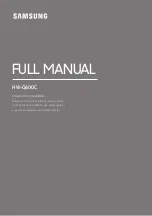
17
250Hz
and the factory default setting is
60Hz
. See Section 11.5
for further guidance on setting this parameter.
11.4.3 Invert
Invert
switches (inverts) the acoustic phase (polarity) of the
n-SUB
. Inverting phase can be of value when deciding on the
optimum position for a sub-woofer. It is worth experimenting with
phase inversion before ruling out a particular sub-woofer position
for reasons of poor integration with the satellite speakers. The
options are
yes
or
no
and the factory default setting is
no
.
11.4.4 Input
Input
selects one of the three
n-SUB
inputs described in Section
11.2.1. The options are
AV
,
AMP
or
AUX
and the factory default
setting is
AV
.
11.4.5 Lock
Lock mode prevents
n-SUB
parameters other than gain, mute
and preset selection from being changed, thus ensuring that
inadvertent adjustments are not made and that daisy-chained
n-SUB
arrays remain synchronised.
To lock a single
n-SUB
use the handset
mode
5
or
mode
6
keys (control panel:
mode
) to select lock followed by the
handset
up
or
down
keys (control panel:
up
or
down
buttons)
to select
1
. When lock mode is active the lock indicator remains
illuminated.
Note:
Settings cannot be adjusted from the control panel when lock
mode is operational.
With multiple
n-SUBs
, lock mode must be configured from the
control panel for each
n-SUB
in turn. Use the control panel
mode
button to select
lock
, followed by the
up
or
down
buttons
to select a different lock number, from
1
to
6
for each
n-SUB
.
Note:
While there is no technical limit on the number of n-SUBs
that can be daisy-chained, six is the recommended practical
maximum.
Once an
n-SUB
has been allocated a lock number it can be
temporarily unlocked for adjustment (and re-locked) by pressing
and holding the appropriate handset
numeric
key (control panel:
press and hold the
mode
button). The lock indicator will flash to
indicate that it is temporarily unlocked.
Note:
Individual locking and unlocking enables subsequent
adjustments to specific daisy-chained n-SUBs to be made without
changing the settings of the other n-SUBs.
To permanently unlock an
n-SUB
it must first be temporarily
unlocked, then the handset
mode
5
or
mode
6
keys (control
panel:
mode
) used to select
lock
, followed by the handset
up
or
down
keys (control panel:
up
or
down
buttons) to select
OFF
.
11.4.6 Label
A three character alpha-numeric display label can be defined for
each
n-SUB
preset. Use the handset
mode
5
or
mode
6
keys
(control panel:
mode
) to select
label,
followed by the handset
mute
key to select the character position and the
up
or
down
keys (control panel:
up
or
down
buttons) to select an alpha-
numeric character.
11.5 n-SUB Gain, Filter Frequency and Polarity
Setting
n-SUB
gain
, filter (
freq
) and polarity (
invert
) parameters
will require some careful listening and experimentation if
optimum subjective performance is to be achieved. Try to put
yourself in the position of the film sound designer or music mix
engineer and aim for a sound that is consistent, well balanced
and free of undue bass or midrange emphasis. It may be useful
to listen with and without the
n-SUB
by using its
mute
function.
Note:
Don’t use the mute function rapidly and repeatedly in order
to judge the n-SUB’s contribution to the sound. Listen to a few
minutes of material with the n-SUB operating and then repeat
the same few minutes with it muted. Use a variety of programme
material but make sure it has an adequate level of low bass.
11.5.1 AV System
When connected to an AV processor, such as the Naim AV2,
the
n-SUB
filter
should always be set at its maximum -
250Hz
.
This is because the processor’s sub-woofer (LFE) channel itself
incorporates low pass filtering.
n-SUB
gain
should be set such
that low frequency effects do not dominate but integrate within
the context of the film. Only use the
invert
function if it proves
difficult to achieve a satisfactory result through adjusting the
gain
. If the
invert
function still results in no improvement, the
n-SUB
should be moved to an alternative location in the room.
Note:
Ensure that the processor’s “midnight” or “bass mix”
functions are not operational when setting up the n-SUB.
Note:
Different gain settings for music only and audio-visual
programme material via an AV processor may be appropriate. Use
the n-SUB’s preset feature to save appropriate settings.
11.5.2 n-SUB with n-SATS - Stereo Music System
For
n-SUB
integration with one pair of
n-SATS
in a conventional
stereo audio system, initially set the
filter
to
60Hz
(the default
value). Optimum
n-SUB
gain
will depend on the room acoustic
and the position of the speakers within it. An
n-SUB
close to the
listening position should, in theory, require less gain, however,
if close to the listening position means the
n-SUB
is relatively
distant from the walls, increased gain will likely be required.
Aim to set the
gain
such that bass elements of the music are
properly integrated. If bass subjectively draws attention to itself,
the
n-SUB
gain is probably too high. Only use the
n-SUB’
s
invert
function if it proves difficult to achieve a satisfactory result
through adjusting the
gain
. If the
invert
function still results in
no improvement the
n-SUB
should be moved to an alternative
location in the room.
Once the
gain
is set, it may be worthwhile experimenting with
small changes in
filter frequency
to fine tune the integration
between
n-SUB
and
n-SATS.
11.5.3 n-SUB with alternative speakers - Stereo Music
System
Larger satellite loudspeakers than the
n-SATS
will most likely
require the
n-SUB
filter
to be reduced. For medium sized stand-
mount loudspeakers begin with a setting of around
50Hz
. For
floor-stand loudspeakers initially set the
filter
to around
40Hz
.
Gain
and
invert
should be set as described above.
n-SUB




































